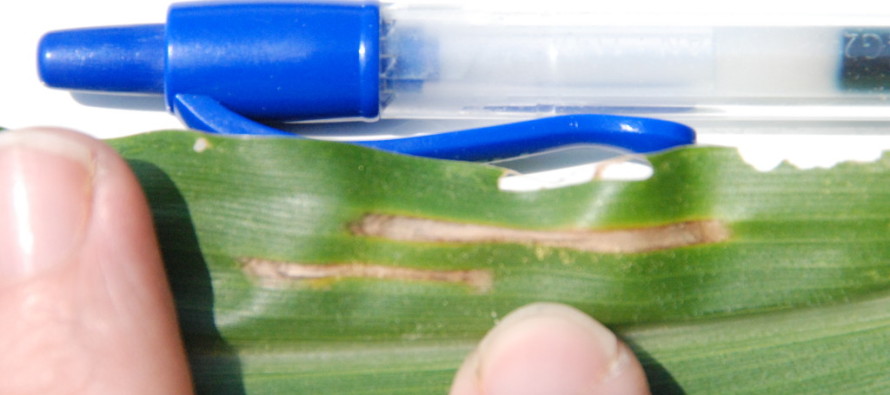Corn Disease Update: June 19, 2015

For the most part, corn diseases have been few and far between. Over the past two weeks I have received limited telephone calls regarding foliar diseases. However, in scouting a few fields over the past ten days I have been able to observe limited foliar disease activity, which at this point in the season is a good sign.
Common rust
Common rust has been observed in extremely limited instances throughout the MS corn crop. The foliar disease is never economically damaging and does not require a fungicide application. Keep in mind that common rust low in the plant canopy can be confused with southern rust so scout fields accordingly and spend the most time observing disease at the ear leaf and above.
Common rust can occur on both sides of the leaf (top and bottom). Lesions are typically longer than southern rust and the sporulation that erupts through the leaf surface tends to be a brown color rather than the bright orange of southern rust. Generally speaking, common rust prefers cooler temperatures and can occur anywhere on the corn plant including on the husk.

Diplodia leaf streak and Diplodia ear rot of corn. Bottom image shows the length that some lesions can reach.
Diplodia leaf streak
Diplodia leaf streak is a disease that favors fields with a history of corn production and cooler and wetter environmental conditions. Over the past 8 years I have only seen Diplodia leaf streak in limited locations, and prior to 2014 I had only seen the disease with one consultant. As of last week I observed Diplodia leaf streak in two fields in western Leflore County. The symptoms associated with the disease will appear similar to Northern corn leaf blight. However, the lesions can be longer than NCLB and range in size from ½ inch to as long as 6+ inches. Lesions will generally have a defined yellow halo with dark pepper grains embedded in the leaf tissue in the most mature lesions. Early symptoms of the disease can begin as dark, water-soaked lesions that will appear along the leaf in a defined line, most often where the portion of the leaf was exposed from within the whorl. Diplodia diseases in corn can produce symptoms on the leaf (Diplodia leaf streak), stalk (Diplodia stalk rot) as well as the ear (Diplodia ear rot). Fungicides are not specifically labeled for Diplodia leaf streak and likely are not effective once the disease is observed. At present, the Diplodia leaf streak observed was middle to lower canopy and had not progressed to severe levels. In fact, in the two fields scouted, the disease was difficult to find and not present on numerous plants.
Gray leaf spot
As of today (6/19) I have not received a single call regarding gray leaf spot. However, last week I observed early gray leaf spot in a field of VT corn in western Leflore County. The area has had a history of corn production and gray leaf spot is not a surprise in these particular fields. Typically gray leaf spot occurs on leaves after the ear has started to form. However, in fields with a history of continuous corn production as well as gray leaf spot occurrence the disease can occur (albeit rarely) in vegetative corn. Lesions are typically shaped like a rectangle and when held to the light have a faint yellow halo. The lesions do not cross the veins and are generally less than an inch in length to 1.5 inches in the most mature lesion type. Some hybrids, with good tolerance to the disease, can keep the disease low in the plant canopy whereby lesions will not occur above the ear leaf. Scout fields with a history of continuous corn more carefully and monitor lesion development.
Northern corn leaf blight
I have only received a few telephone calls regarding NCLB. In addition, I have struggled to find NCLB in my fungicide trial plots as well as fields I have scouted around the Delta. NCLB is one of those diseases that can cause alarm. The lesions can be large, 1 to 3 inches in length, but rarely is the disease a major yield reducer. Corn hybrids with poor disease packages or hybrids that are extremely susceptible to NCLB should be scouting carefully. Finding one lesion per plant and then having to struggle to find additional lesions does not mean that a fungicide needs to be applied. Remember, one lesion per leaf per plant is far less than 1% of the measureable leaf surface area of a corn plant. For yield loss to occur in a corn plant much more than 1% of the photosynthetic leaf surface area needs to be covered. Keep in mind that injury as a result of a foliar nutrient application can be mistaken for NCLB. Typically, the lesions associated with a foliar nutrient application will appear more shredded and oftentimes will occur in a pattern on the leaf surface since that part of the leaf was exposed to the application or may have remained down in the whorl at the time of application.
Southern rust
No southern rust has been reported from MS nor from the region (AL, AR, LA) to date (6/19). At present the only southern rust reported has been from southern Georgia.







Let me tell You a sad story ! There are no comments yet, but You can be first one to comment this article.
Write a comment